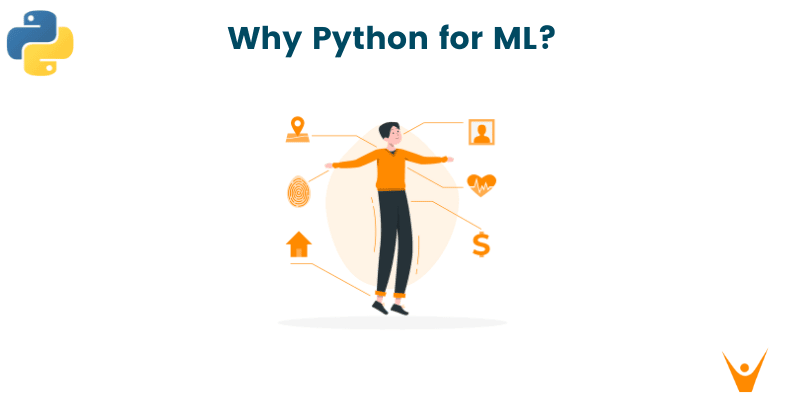We are all aware of how crucial it is to manage the enormous amount of data and automate decision-making in today's era of technological innovation. Because of this, ML and AI are required. But why Python is the most popular programming language for Machine Learning? Let's check that out.
Why choose Python for Machine Learning?
Due to its capacity to analyze enormous datasets, spot patterns, and make predictions, machine learning has become an essential component of many industries, including healthcare, finance, manufacturing, and education. You can also check this Machine Learning guide for beginners to start your journey.
Now, there are many popular programming languages right now, like C++, Java, and even JavaScript. But still, Python stands out among all of them for Machine Learning. Why? The basic reasons are that it is user-friendly, adaptable, and has some powerful libraries built-in to tackle challenging challenges.
Let's learn about all the 8 benefits that Python offers for machine learning:
- Independence across platforms: Python is intended to be very independent and portable across various platforms. This implies that the code does not require platform-specific adjustments in order to operate on a variety of OSs, including Windows, macOS, Linux, and others.
- Libraries & Frameworks: The dependable environment provided by Python speed up the development process dramatically. When working on large projects, developers can leverage NumPy, Pandas, TensorFlow, and PyTorch to essentially employ prewritten code and use tools for preprocessing, data manipulation, and model building.
- Open-Source: Python is an open-source language, which means that anyone is free to use and alter the code for the interpreter, standard library, and many other libraries and tools.
- Scalability: Large data sets and intricate algorithms can be handled by the scalable language Python. It is the perfect language for machine learning because of its ability to extend horizontally and effectively handle enormous datasets.
- Easy to Learn: Python is a simple and easy-to-learn language compared to C++ or Java, which makes it best for beginners in Machine Learning.
- Flexibility: Python is frequently used in conjunction with other platform-independent technologies for web development, such as HTML, CSS, and JavaScript, as well as with multi-platform database systems like MySQL or PostgreSQL.
- Large Community: Python has a large and active community of developers who contribute to open-source libraries and tools. Additionally, this vibrant developer community makes it easy to find help and support.
- Fast prototyping: You can easily and quickly make ML models or prototypes using Python's functionalities. This is great for experimentation and testing before actual development.
According to a GitHub report, Python is still continuing to a 22.5% year-over-year increase in popularity, which is partly because of its utility in data science and machine learning.
Why is Java not used for ML?
Java is considered to be a faster programming language than Python during runtime and is also widely used by many coders around the world. Despite this, Java lacks some features for Machine Learning.
One factor for this is that Java is a statically-typed language, which implies that variables' data types must be defined at compile-time and that changing these data types at runtime might be difficult. In contrast, dynamic data formats and the capacity for real-time data modification and manipulation are frequently necessary for machine learning algorithms.
Another factor is that, in contrast to other programming languages like Python or R, Java lacks a robust ecosystem of machine learning tools and frameworks. Even though there are a few machine learning libraries for Java, such as Weka and Deeplearning4j, they are not as developed or well-known as those for other languages.
Java's verbosity and boilerplate code can also make it more challenging to create and debug machine-learning programs, which necessitates extensive testing and experimentation. This is solved in Python as it codes are usually 3-4 times shorter than Java codes so they are easy to debug.
Overall, despite the fact that Java can be used for machine learning, most researchers and practitioners do not choose it because of its verbosity, lack of flexibility, and lack of library support.
Applications of Python in Machine Learning
Here are some basic applications of Python for Machine Learning:
-
Python is frequently used for tasks like cleaning and preparing data for machine learning algorithms.
-
It has a number of well-known machine learning libraries and frameworks, including TensorFlow, Keras, PyTorch, and Scikit-learn, which give programmers effective tools for creating machine learning models.
-
Python is the language of choice for deep learning, a branch of machine learning that uses neural networks. Python has become the preferred language for deep learning practitioners thanks to the creation of well-known deep learning tools like TensorFlow and PyTorch.
-
It is frequently used for Natural Language Processing (NLP) activities including text analysis and sentiment analysis. For NLP tasks, libraries like NLTK and spaCy are frequently used.
-
It is also frequently used for tasks involving computer vision, such as the analysis of images and videos, thanks to libraries like OpenCV and PyTorch.
Conclusion
After reading this article, you can confidently say why Python is best to learn for Machine Learning and why it is preferred over others. It is an excellent choice because of its simplicity, versatility, and the vast range of libraries specifically designed for Machine Learning.








